Disaster tourists flock to Eiger
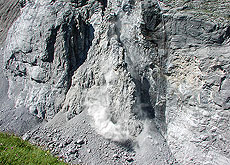
The spectacular mass of rock breaking off the Eiger mountain has become an unexpected tourist attraction for the resort of Grindelwald.
Hundreds of hikers and hordes of journalists have taken up position each day to watch the Eiger slowly shed a large chunk of its eastern flank, and ponder what it says about global warming.
Those fascinated by the Eiger usually come to stare in awe at its formidable North Face, once considered insurmountable by alpinists. But all that has changed since mid-June when large fissures were first spotted on the mountain’s eastern side.
Geologists began working hand in hand with mountain guides to install an infrared system to measure the size of the disintegrating slab and the speed of its imminent collapse.
The spotlight was put firmly on Eiger East when word got out that it could only be a matter of days before a two million cubic metre chunk of rock – about the volume of two Empire State buildings – came crashing down.
A record of sorts was set last Sunday when around 1,000 people pulled on hiking boots and hats, and trekked up the opposite mountainside to rubberneck. And minor rockslides sending up plumes of dust were enough to entertain the masses up until Thursday evening when a large piece finally did break off.
Interviewed on radio and television, the head of Grindelwald’s rescue services, Kurt Amacher, told an excited nation that the rubble-reduced rock amounted to 700,000 cubic metres – or one-third of the endangered slab.
Amacher cut his estimate by nearly half when questioned by swissinfo and other media representatives who took part in Friday’s pilgrimage. Many of his answers and the explanations of geologist Hans Rudolf Keusen were drowned out by the roar of helicopters airlifting camera crews into position.
“It could disintegrate rather unspectacularly from now on, with many small rockslides,” cautioned Keusen, before being asked the inevitable question about what could cause a rockslide on a scale only seen every few decades.
Water pressure
“One hundred and fifty years ago, the glacier reached up to the uppermost part where the rock is now breaking away,” Keusen repeated with patience. “Now it’s 200 metres lower so it’s no longer supporting the cliff and without it, the rock has loosened and cracked, allowing water to seep in, creating a lot of pressure.”
“We’re going to have more situations like this in future,” added Amacher, pointing the finger clearly at rising temperatures caused by global warming.
But there are short-term benefits. The couple who run the mountain hut across the gorge and opposite the crumbling cliff have seen visitor numbers triple compared with last year. And their “rockslide” coffee spiked with schnapps has been a big seller at SFr7.50 a glass ($6.06).
“I personally can’t do anything to stop global warming,” said hut manager Hansruedi Burgener. “We are at least making people aware of the consequences of climate change. You can see the effects up here.”
The hut only opened a few weeks ago. The previous lodge was abandoned when the slope it was on began to give way for the very same reason that has led to the instability of the Eiger flank.
That event last summer was a small sensation in itself. And many spectators bored with watching the Eiger’s slow demise, have wandered along the path to look down on where the building once stood.
Abyss
There are no guarantees that the new structure will not eventually slide into the abyss as well, but Burgener believes it is on solid mountain ground – as much as it can be when there are few certainties due to climate change.
Earlier this week, a female hiker was buried under a mudslide while walking along a popular trail considered safe in the southeastern Engadine valley. Her death was followed by a warning from a top glaciologist to avoid paths near glacier-fed streams.
The expert said the extent of the glacial retreats in Switzerland and the thawing of the permafrost layer had created an unusually high number of lakes of melt water which could burst through loose dams of detritus anywhere and at any time.
And summer rains have become more torrential. The road and railway line to Grindelwald follows the stream fed by the resort’s melting glaciers. Instead of green pastures, there are fields of mud on both sides of the watercourse – the remains of last August’s flooding.
swissinfo, Dale Bechtel in Grindelwald
Switzerland’s glaciers lost 18% of their surface between 1985 and 2000. In the Alps, the average loss has been 22%.
Swiss glaciers are melting more slowly because most of them are at high altitude.
Meltdown affects smaller glaciers – which represent 18% of total glacier surface but nearly half the losses incurred – first, according to a 2004 study from Zurich University.
The Eiger at 3,970 metres above sea level is one of the most renowned mountains in Switzerland, with its north face offering a major challenge to climbers.
Thursday’s fall of rock from the mountain is a further example of instability throughout the Swiss Alps.
On Monday a 70-year-old German was killed by a huge mudslide that descended from a glacier in the Corvatsch region of canton Graubünden.
At the end of May, rocks fell on the main north-south road axis north of the Gotthard tunnel, killing two Germans in their car. As a result, dangerous overhanging rock had to be removed and the motorway was closed for a month.

In compliance with the JTI standards
More: SWI swissinfo.ch certified by the Journalism Trust Initiative

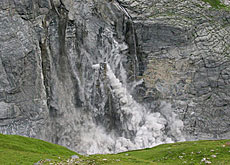
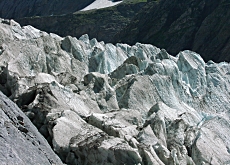
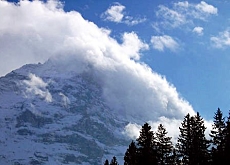
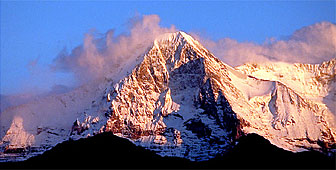
You can find an overview of ongoing debates with our journalists here. Please join us!
If you want to start a conversation about a topic raised in this article or want to report factual errors, email us at english@swissinfo.ch.